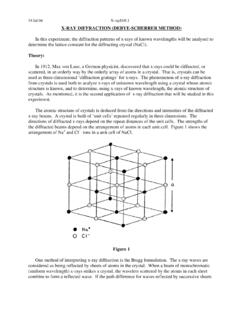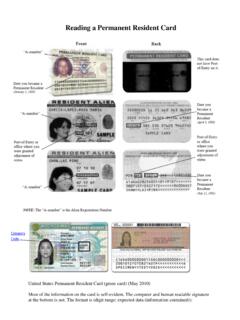Transcription of 1826: First Permanent Image French inventor Joseph ...
1 1826: First Permanent ImageFrench inventor Joseph Nic phore Ni pce uses a camera obscura to burn a Permanent Image of the countryside at his Le Gras, France, estate onto a chemical-coated pewter plate. He names his technique "heliography," meaning "sun drawing." The black-and-white exposure takes eight hours and fades significantly, but an Image is still visible on the plate of advances in chemistry and optics, including the invention of the camera obscura, set the stage for the world s First photograph. In 1826, French scientist Joseph Nic phore Ni pce, took that photograph, titled View from the Window at Le Gras at his family s country home. Ni pce produced his photo a view of a courtyard and outbuildings seen from the house s upstairs window by exposing a bitumen-coated plate in a camera obscura for several hours on his by Nic phore Ni pce1839: First Photo of a PersonIn early 1839, French painter and chemist Louis-Jacques-Mand Daguerre photographs a Paris street scene from his apartment window using a camera obscura and his newly invented daguerreotype process.
2 The long exposure time (several minutes) means moving objects like pedestrians and carriages don't appear in the photo. But an unidentified man who stops for a shoeshine remains still long enough to unwittingly become the First person ever : First Photo of LightningIn 1847, early photography pioneer Thomas Easterly makes a daguerreotype of a bolt of lightning the First picture to capture the natural phenomenon. Primarily a portraitist, Easterly also makes pictures of landscapes, unusual for : First Photos of WarIn 1847, during the Mexican-American War, daguerreotypist Charles J. Betts follows the American Army to Veracruz, Mexico, and, according to an advertisement, offers to photograph "the dead and wounded." Dozens of anonymous daguerreotypes are also taken of troop movements and American officers. The First official war photos, though, are of the Crimean War from 1855 to 1856. The British government sends several photographers to document the war, but because of his meticulous preparations, Roger Fenton, a British solicitor turned noted photographer, is the only one to get good results.
3 He and his assistants take some 350 images, mainly : First Bird's-Eye ViewFelix Tournachon, better known by the nom de plume Nadar, combines his interests aeronautics, journalism, and photography and becomes the First to capture an aerial photograph in a tethered balloon over Paris in : First Color PhotoThe enormously influential Scottish physicist James Clerk Maxwell creates a rudimentary color Image by superimposing onto a single screen three black-and-white images each passed through three filters red, green, and blue. His photo of a multicolored ribbon is the First to prove the efficacy of the three-color method, until then just a theory, and sets the stage for further color innovation, particularly by the Lumi re brothers in : First Action PhotosCalifornia photographer Eadweard Muybridge, using new emulsions that allow nearly instantaneous photography, begins taking photograph sequences that capture animals and humans in motion.
4 His 1878 photo series of a trotting horse, created with 12 cameras each outfitted with a trip wire, helps settle a disagreement over whether all four of a horse's hooves leave the ground during a trot. (They do.) It also causes a popular stir about the potential of cameras to study movement. Muybridge goes on to create hundreds of Image sequences with humans and animals as subjects. These photo series are linked to the earliest beginnings of : First Tornado PhotoTaken by an unknown photographer, this Image is thought to be the oldest existing photo of a tornado. According to the National Weather Service, it was taken on August 28, 1884, about 22 miles (35 kilometers) southwest of Howard, South : First Photo Published in National GeographicThe First photograph to appear in National Geographic is a relief map of North America. It appears in the magazine's third issue (Volume 1, Number 3, 1889). The First photograph of a natural scene generally considered the First real photograph in the magazine is of Herald Island, in the Arctic Ocean, taken from a ship and appearing in the March 1890 : First National Geographic Photo SeriesNational Geographic magazine publishes its First stand-alone photographic series in 1905.
5 The piece, a photographic tour of Lhasa, Tibet, runs in the January 1905 issue and fills 11 pages. Magazine Editor Gilbert H. Grosvenor is congratulated by National Geographic Society members but reveals later that he expected the pictorial to get him : First National Geographic Wildlife PhotosNational Geographic begins its long, celebrated association with wildlife photography with its July 1906 issue. In a feature titled "Photographing Wild Game with Flashlight and Camera," the magazine publishes some 70 wildlife photographs by Rep. George Shiras, many taken at night using flash powder. The decision to publish the pictorial causes two board members to resign, protesting that "wandering off into nature is not geography." But Editor Gilbert H. Grosvenor later describes the piece as "an extraordinarily educative series: Nobody had ever seen pictures like that of wild animals."1909: First Photos of the North PoleOn April 6, 1909, Robert E.
6 Peary and his assistant, Matthew Henson, become the First people to reach, and photograph, the North Pole. The mission, supported by the National Geographic Society, was a grueling, 37-day dogsled journey over 475 miles (760 kilometers) of ice. The feat is immediately questioned by skeptics who say Peary's navigation and reckoning were dodgy and that the round-trip could not have been completed so quickly. Nearly 100 years later, the veracity of the claim still remains in : First Photos of Machu PicchuFrom 1912 to 1915, the National Geographic Society supports expeditions by Yale University professor and explorer Hiram Bingham to excavate the ancient Inca city of Machu Picchu in the Peruvian Andes. Bingham's photos in National Geographic are among the First ever published of the mysterious Inca : First Natural-Color Photo in National GeographicThe July 1914 issue of National Geographic magazine features its First Autochrome, or natural-color photograph a flower garden in Ghent, Belgium.
7 The magazine had used hand-colored images since November 1910. In April 1916, National Geographic becomes one of the First American publications to run a series of Autochrome color : First Underwater Color PhotoIchthyologist William Longley and National Geographic staff photographer Charles Martin use an Autochrome camera and a raft full of explosive magnesium flash powder to illuminate the shallows of Florida's Dry Tortugas and make the First undersea color photographs. The photos, which show reef scenes with fish, are published in the January 1927 National : First High-Altitude PhotoNational Geographic teams up with the Army Air Corps for the record-breaking flight of Explorer II, a helium balloon with a hermetically sealed magnesium alloy gondola. The balloon takes off near Rapid City, South Dakota, and ascends 72,395 feet (22,066 meters) into the stratosphere, a world altitude record for manned flight.
8 Captain Albert Stevens takes the First photograph showing the curve of the Earth and the First color photographs taken from the : First High-Speed Photography ImagesDr. Harold "Doc" Edgerton, a professor of electrical engineering at the Massachusetts Institute of Technology, works with National Geographic to perfect high-speed stroboscopic photography, freezing on film the rapid movements of nature that elude the eye. National Geographic publishes several of the images, including bullets frozen in mid-flight and stilled hummingbird wings. Nicknamed "Papa Flash," Edgerton's techniques are later used to illuminate the ocean's deepest : First Photo on National Geographic CoverFor its July 1943 issue, National Geographic spruces up its normally staid yellow-and-white cover with a photo of a billowing American flag. The decision was made after a wartime plea by the Treasury Department for all major magazines to print a flag on their June or July covers, hoping to encourage the purchase of war bonds.
9 The words "Buy War Savings Bonds and Stamps" also appear at the top of the : First Photo Taken From SpaceResearchers with the Johns Hopkins University Applied Physics Laboratory strap a 35-millimeter camera to a German V-2 missile and launch it into space from White Sands Missile Range in New Mexico. The camera snaps a picture every second and a half as the rocket ascends to 65 miles (105 kilometers) above the surface. The camera falls back to Earth and slams into the ground, but the film, contained in a steel cassette, is unharmed. The developed photos are the First ever to show Earth from space, a grainy black-and-white wedge of planet framed against the black expanse. Hundreds of newspapers and magazine run the '56: First Survey of the Night SkyNational Geographic teams up with the California Institute of Technology for the Palomar Observatory Sky Survey, a seven-year project to produce the First photographic map of the Northern Hemisphere's night sky.
10 The work is done at the Palomar Observatory in California using "Big Schmidt," a new, 48-inch (122-centimeter) camera telescope. The result is a comprehensive study of the heavens that leads to the discovery of many new stars and galaxies and is still used by astronomers : OceanEye InventedFrustrated by the inability to shoot wide-angle photos using currently available underwater housings, National Geographic photographer Bates Littlehales works with the National Geographic photo lab and the Photogrammetry Corporation to design a better model. The result, essentially a transparent Plexiglas bubble with a set of handles and controls, revolutionizes underwater photography. Dubbed OceanEye, the new housing can accommodate a camera with a bulky motor drive as well as a wide range of lenses. And its near-perfect optics allow photographers to take wide shots as well as close-ups without the light distortion caused by : First All-Color After decades of pioneering color photography technology, National Geographic magazine introduces a new era in February 1962, becoming the First major American periodical to print an all-color issue.









